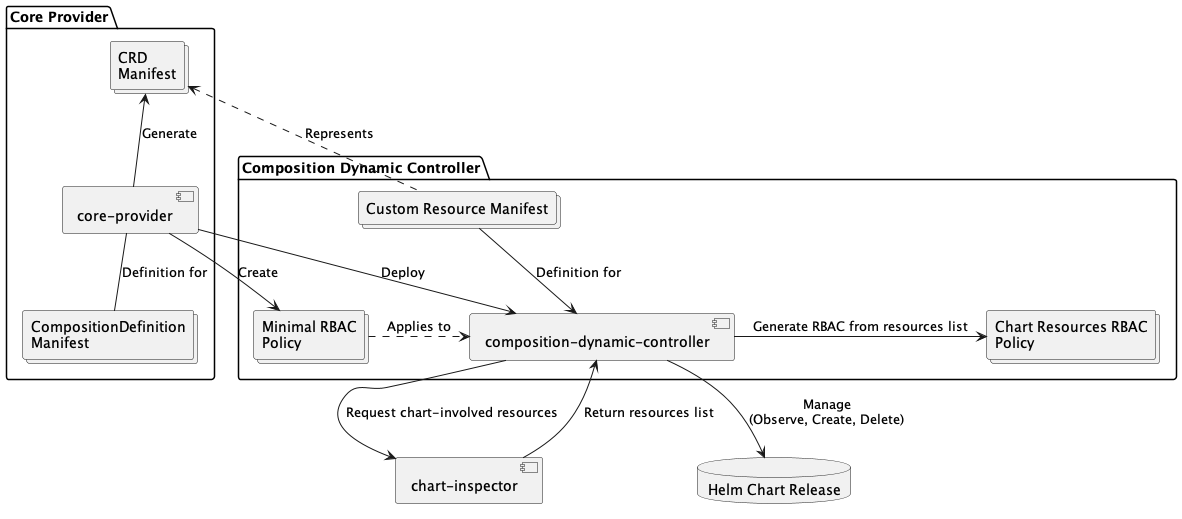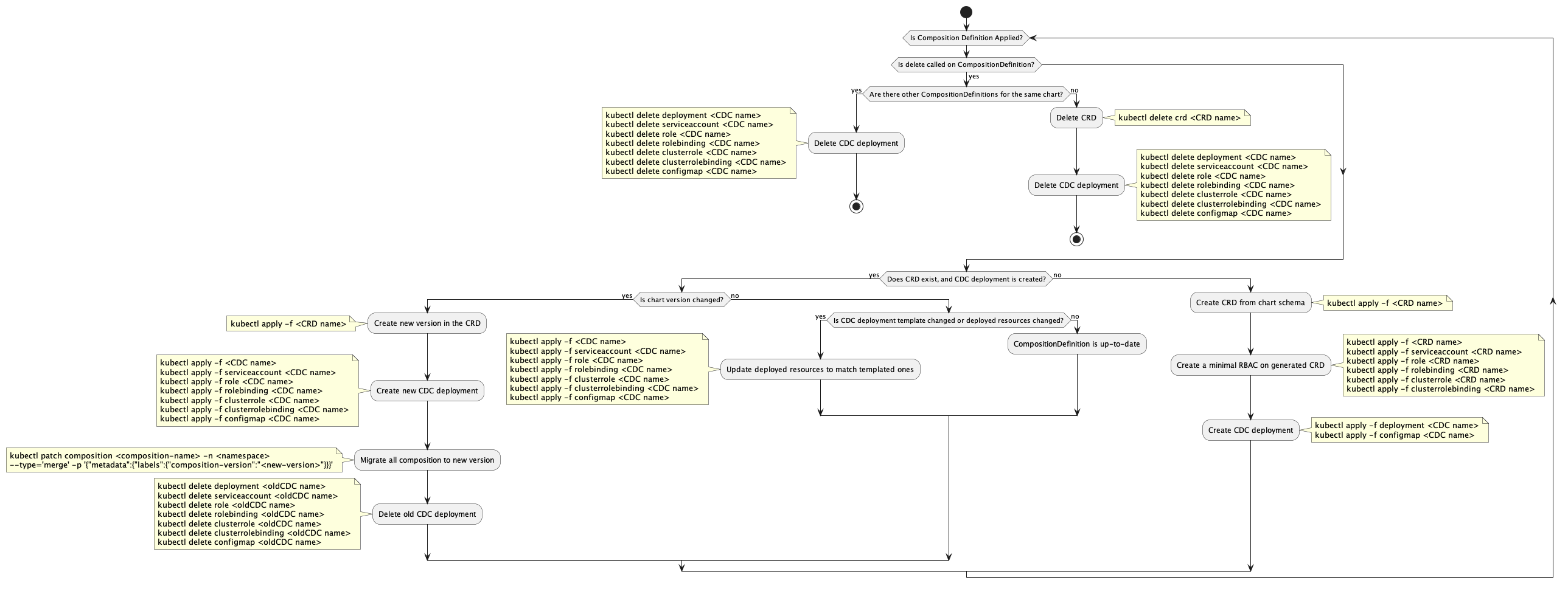core-provider
The Krateo Core Provider is the foundational component of Krateo Composable Operations (KCO), enabling the management of Helm charts as Kubernetes-native resources. It provides:
- Schema validation through JSON Schema
- Automated CRD generation
- Versioned composition management
- Secure authentication mechanisms
Summary
- Summary
- Glossary
- Architecture
- Workflow
- Requirements
- CompositionDefinition specifications and examples
- How to Install
- Examples and Troubleshooting
- Environment Variables and Flags
- Security Features
- Best Practices
Glossary
- CRD (Custom Resource Definition): A Kubernetes resource that defines custom objects and their schemas, enabling users to extend Kubernetes functionality.
- CompositionDefinition: A custom resource in the
core-providerthat defines how Helm charts are managed and deployed in Kubernetes. - CDC (Composition Dynamic Controller): A controller deployed by the
core-providerto manage resources defined by aCompositionDefinition. This controller is responsible to create, update, and delete helm releases and their associated resources based on the values defined in thecomposition - Helm Chart: A package of pre-configured Kubernetes resources used to deploy applications.
- OCI Registry: A container registry that supports the Open Container Initiative (OCI) image format, used for storing and distributing Helm charts.
- RBAC Policy: A set of rules that define permissions for accessing Kubernetes resources. Typically composed of roles, role bindings, cluster roles, and cluster role bindings assigned to service accounts.
- values.schema.json: A JSON Schema file included in Helm charts to define and validate the structure of
values.yaml.
Architecture

This diagram outlines the high-level architecture and interactions within the Core Provider, responsible for managing CompositionDefinitions and related resources. It illustrates the relationships between key components such as the Core Provider itself, the Composition Dynamic Controller (CDC), the Chart Inspector, and various Kubernetes resources.
The Core Provider generates CRDs, creates RBAC policies, and deploys the CDC. The CDC manages Helm chart releases, requests resource information from the Chart Inspector, and generates RBAC policies based on those resources. The diagram highlights the flow of definitions and resources between these components, showcasing how the Core Provider orchestrates the deployment and management of composed applications within a Kubernetes cluster.
Workflow

This diagram illustrates the Core Provider's workflow for managing CompositionDefinitions, which define how resources are composed and managed in a Kubernetes environment. It encompasses the lifecycle of Helm releases and associated resources, involving the creation and updating of CRDs (Custom Resource Definitions), RBAC (Role-Based Access Control), and CDC (Composition Dynamic Controller) deployments. These actions are conditional, based on chart versions and the current state of the cluster.
The kubectl commands within the notes serve as illustrative examples of the operations performed by the Core Provider and are not intended for direct user execution. They provide insights into the resource management processes undertaken by the system.
Requirements
The core-provider does not requires Snowplow anymore to be installed in the cluster. The core-provider is now able to retrieve resource plurals from the cluster without Snowplow. This change was introduced in version 0.24.2 of the core-provider.
CompositionDefinition specifications and examples
The core-provider is a Kubernetes operator that downloads and manages Helm charts. It checks for the existence of values.schema.json and uses it to generate a Custom Resource Definition (CRD) in Kubernetes, accurately representing the possible values that can be expressed for the installation of the chart.
Kubernetes is designed to validate resource inputs before applying them to the cluster, and the core-provider provides input validation to ensure that incorrect inputs are not accepted.
Authentication
The core-provider also handles authentication to private OCI registries and Helm repositories. Users can provide their credentials through Kubernetes secrets, and the core-provider will use them to download the necessary chart resources.
OCI Registry
Create the Kubernetes secret:
kubectl create secret generic docker-hub --from-literal=token=your_token -n krateo-system
apiVersion: core.krateo.io/v1alpha1
kind: CompositionDefinition
metadata:
annotations:
"krateo.io/connector-verbose": "true"
name: fireworks-private
namespace: krateo-system
spec:
chart:
url: oci://registry-1.docker.io/yourusername/fireworks-app
version: "0.1.0"
credentials:
username: yourusername
passwordRef:
key: token
name: docker-hub
namespace: krateo-system
GCP Artifact Registry
Follow this guide to create a service account key. You will need to download the .json file containing the key and create the Kubernetes secret from it. Note that the service account should have permissions to download from the Google Artifact Registry.
Now, create a secret from the JSON file containing your service account key:
kubectl create secret generic gcp-sa-secret -n demo \
--from-file=secret-access-credentials=/path/to/file/krateoregistry-3d546566ae4a.json
apiVersion: core.krateo.io/v1alpha1
kind: CompositionDefinition
metadata:
name: fireworks-private
namespace: krateo-system
spec:
chart:
url: oci://europe-west12-docker.pkg.dev/krateoregistry/krateotest/fireworks-app
version: "0.0.1"
credentials:
username: json_key
passwordRef: # reference to a secret
key: secret-access-credentials
name: gcp-sa-secret
namespace: demo
The spec.chart.credentials.username should be set to json_key as explained in this documentation.
Helm Repository
kubectl create secret generic helm-repo --from-literal=token=your_token -n krateo-system
apiVersion: core.krateo.io/v1alpha1
kind: CompositionDefinition
metadata:
annotations:
"krateo.io/connector-verbose": "true"
name: fireworks-private
namespace: krateo-system
spec:
chart:
repo: fireworks-app
url: https://theurltoyourhelmrepo
version: 0.3.0
credentials:
username: yourusername
passwordRef:
key: token
name: helm-repo
namespace: krateo-system
Composition Definition
A Composition is a Helm Chart archive (.tgz) with a JSON Schema for the values.yaml file. The JSON Schema file must be named values.schema.json.
Our official tool to generate a valid JSON schemas is krateoctl.
CRD Specification
To view the CRD configuration, visit this link.
How to Install
You can install the core-provider with the following commands:
helm repo add krateo https://charts.krateo.io
helm repo update
helm install krateo-core-provider krateo/core-provider --namespace krateo-system --create-namespace
Examples and Troubleshooting
You can see a more practical guide on core-provider usage at this link.
Environment Variables and Flags
| Name | Description | Default Value | Notes |
|---|---|---|---|
HELM_REGISTRY_CONFIG_PATH | Path to Helm registry configuration file | /tmp | Used for OCI registries |
CORE_PROVIDER_DEBUG | Enables debug logging | false | Use --debug flag |
CORE_PROVIDER_SYNC | Sync period for controller manager | 1h | Duration |
CORE_PROVIDER_POLL_INTERVAL | Poll interval for resource drift checks | 5m | Duration |
CORE_PROVIDER_MAX_RECONCILE_RATE | Maximum reconcile rate per second | 3 | Integer |
CORE_PROVIDER_LEADER_ELECTION | Enables leader election for controller manager | false | Use --leader-election flag |
CORE_PROVIDER_MAX_ERROR_RETRY_INTERVAL | Maximum retry interval on errors | 1m | Duration |
CORE_PROVIDER_MIN_ERROR_RETRY_INTERVAL | Minimum retry interval on errors | 1s | Duration |
CORE_PROVIDER_TLS_CERTIFICATE_DURATION | The duration of the TLS certificate. It should be at least 10 minutes and a minimum of 3 times the poll interval. | 24h | Duration |
CORE_PROVIDER_TLS_CERTIFICATE_LEASE_EXPIRATION_MARGIN | The duration of the TLS certificate lease expiration margin. It represents the time before the certificate expires when the lease should be renewed. It must be less than the TLS certificate duration. Consider values of 2/3 or less of the TLS certificate duration. | 16h | Duration |
URL_PLURALS | NOT USED from version 0.24.2 - URL to krateo pluraliser service | http://snowplow.krateo-system.svc.cluster.local:8081/api-info/names | String |
Security Features
- Generates CRDs based on the chart's schema, preventing invalid configurations
- Deploys
composition-dynamic-controllerwith minimal necessary permissions - Removes RBAC policies upon deletion of the CR
- Implements mutating webhook and conversion webhook for enhanced security and flexibility
Best Practices
- Always include a
values.schema.jsonfile in your Helm charts - Use the
krateo.io/pausedannotation to manage composition lifecycle - Leverage the multi-version support for smooth upgrades and rollbacks
By implementing these improvements and best practices, the Krateo Core Provider offers enhanced flexibility, security, and version management capabilities for Kubernetes-based applications.